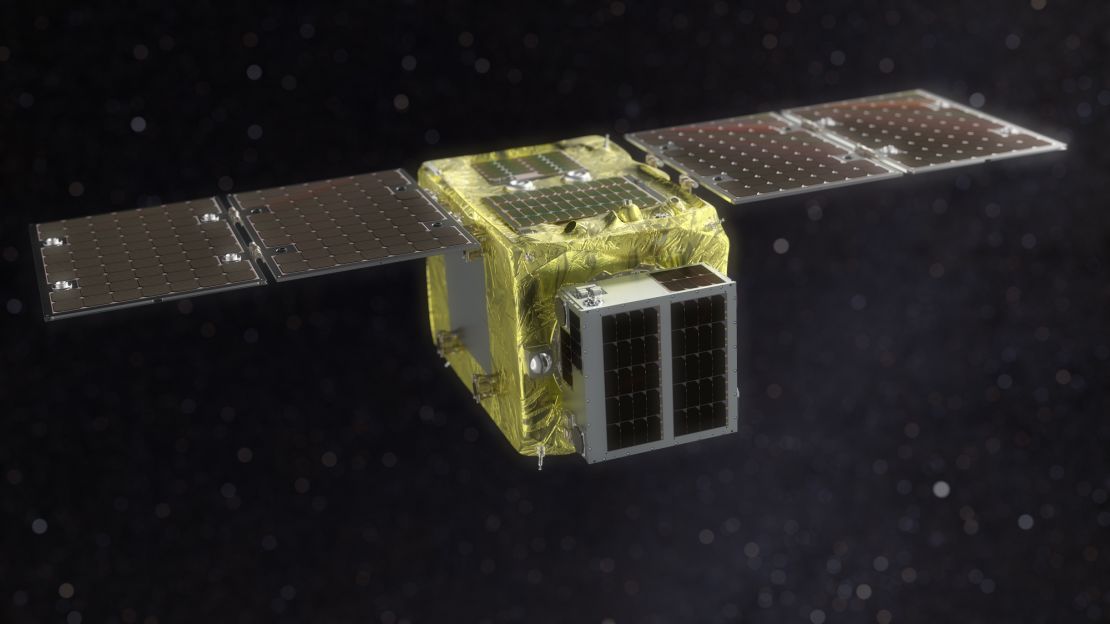It’s invisible in the night sky, but above us there is a cloud of more than 9,000 tons of space junk – equivalent to the weight of 720 school buses.
This debris is composed of parts of old satellites as well as entire defunct satellites and rocket bodies. The debris poses risks to the International Space Station and threatens things we take for granted on Earth – weather forecasting, GPS and telecommunications. It’s a problem that’s getting worse with more and more satellites being launched each year by ventures like Elon Musk’s SpaceX.
A demonstration mission to test new technology developed by the company Astroscale to clean up space debris is set to launch in the early hours of Saturday from the Baikonur Cosmodrome in Kazakhstan.
A Soyuz 2 rocket will launch a 175-kilogram spacecraft with a satellite attached into space. The spacecraft and the 17-kilogram satellite – the debris to be cleaned up – will separate and then perform a high-stakes game of cat and mouse over the next few months.
Astroscale will test the spacecraft’s ability to snatch a satellite and bring it down toward the Earth’s atmosphere, where it will burn up. It will do this in a series of different maneuvers, with the mission expected to end in September or October of this year.
As part of the mission, the company will test whether the spacecraft can catch and dock with the satellite as it tumbles through space at up to 17,500 miles per hour – several times faster than the speed of a bullet.
The tests rely on a magnetic docking plate to latch onto the satellite. Astroscale said it hopes all new satellites being launched will ultimately have this docking plate, allowing them to be safely removed at the end of their life span. What’s more, Astroscale said it had already signed a deal with internet satellite company OneWeb.
“Now is the time to take the threat of debris seriously by committing to debris removal programs and preparing satellites for future removal at their end of life,” said John Auburn, managing director of Astroscale UK and group chief commercial officer.
“Avoiding catastrophic collisions will help to protect the space ecosystem and ensure all orbits can continue to thrive sustainably for generations to come.”
Astroscale is headquartered in Japan but the mission is being controlled from the United Kingdom.

Nets, harpoons and robotic arms
The technology being tested in this mission targets the removal of satellites yet to be launched and doesn’t address the problem of debris already in space. However, the company is working with JAXA, the Japan Aerospace Exploration Agency, on its first debris removal project.
Other space agencies, institutions and companies are also working on technology to remove space junk.
ClearSpace 1, the European Space Agency’s mission to remove space junk from orbit, is expected to launch in 2025. This mission will use four robotic arms to capture the debris.
A 2018 demonstration mission successfully deployed a net to ensnare space junk, the first successful demonstration of space cleanup technology. The RemoveDebris experiment is run by a consortium of companies and researchers led by the UK’s Surrey Space Centre and includes Airbus, Airbus-owned Surrey Satellite Technology Ltd. and France’s Ariane Group. It has also tried a method using a harpoon.
There are at least 26,000 pieces of space junk orbiting the Earth that are the size of a softball or larger and could destroy a satellite on impact; over 500,000 the size of a marble big enough to cause damage to spacecraft or satellites; and over 100 million pieces of debris the size of a grain of salt that could puncture a spacesuit, according to a January report by NASA.
In fact, the report said, the bits of space junk that aremost dangerous to spacecraft and satellites are often the smallest because they are too small to be detected, and operators aren’t able to maneuver to avoid them.












